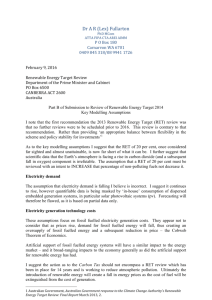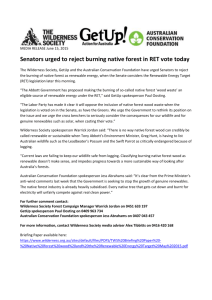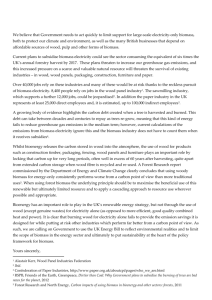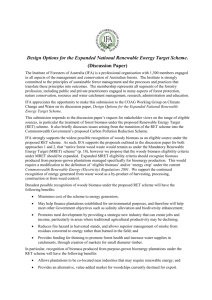EWPissuespaperAFPAsubJan2014final
advertisement
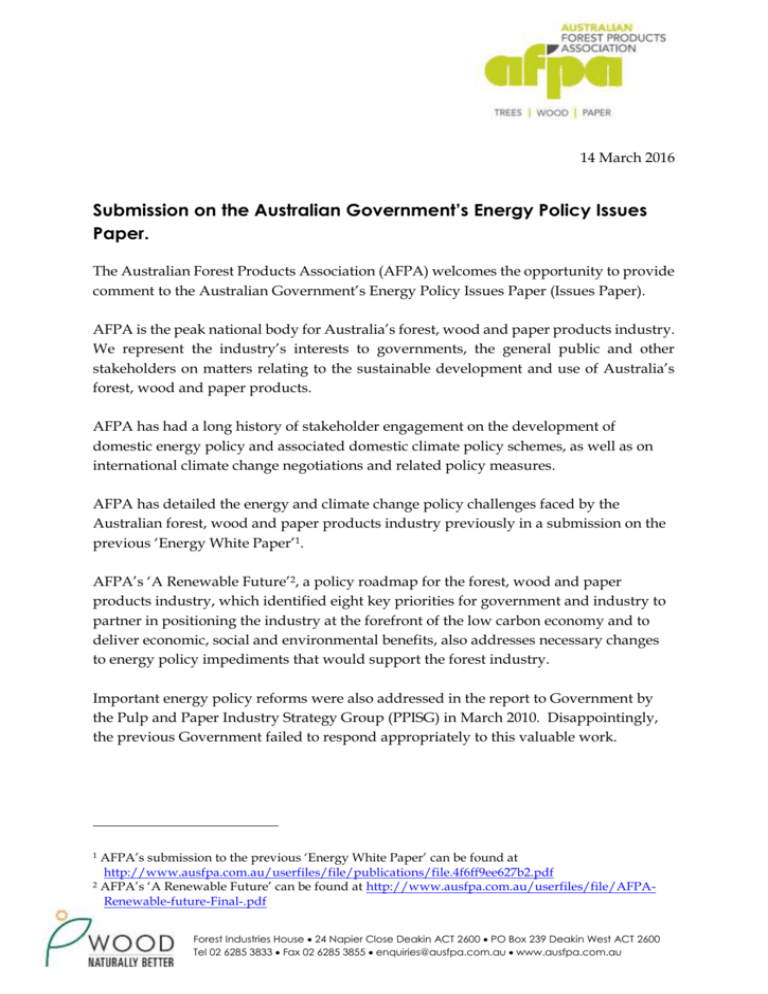
14 March 2016 Submission on the Australian Government’s Energy Policy Issues Paper. The Australian Forest Products Association (AFPA) welcomes the opportunity to provide comment to the Australian Government’s Energy Policy Issues Paper (Issues Paper). AFPA is the peak national body for Australia’s forest, wood and paper products industry. We represent the industry’s interests to governments, the general public and other stakeholders on matters relating to the sustainable development and use of Australia’s forest, wood and paper products. AFPA has had a long history of stakeholder engagement on the development of domestic energy policy and associated domestic climate policy schemes, as well as on international climate change negotiations and related policy measures. AFPA has detailed the energy and climate change policy challenges faced by the Australian forest, wood and paper products industry previously in a submission on the previous ‘Energy White Paper’1. AFPA’s ‘A Renewable Future’2, a policy roadmap for the forest, wood and paper products industry, which identified eight key priorities for government and industry to partner in positioning the industry at the forefront of the low carbon economy and to deliver economic, social and environmental benefits, also addresses necessary changes to energy policy impediments that would support the forest industry. Important energy policy reforms were also addressed in the report to Government by the Pulp and Paper Industry Strategy Group (PPISG) in March 2010. Disappointingly, the previous Government failed to respond appropriately to this valuable work. AFPA’s submission to the previous ‘Energy White Paper’ can be found at http://www.ausfpa.com.au/userfiles/file/publications/file.4f6ff9ee627b2.pdf 2 AFPA’s ‘A Renewable Future’ can be found at http://www.ausfpa.com.au/userfiles/file/AFPARenewable-future-Final-.pdf 1 Forest Industries House 24 Napier Close Deakin ACT 2600 PO Box 239 Deakin West ACT 2600 Tel 02 6285 3833 Fax 02 6285 3855 enquiries@ausfpa.com.au www.ausfpa.com.au Key recommendations of the Strategy Group3 relating specifically to energy and climate change policy which are yet to be addressed and are still considered current, include: Recommendation 11: Increase the availability of renewable energy stock in the Renewable Energy Target (RET) by ensuring that wood waste is classified as a renewable energy input; and include the renewable heat component of cogeneration circuits; Recommendation 14: The Australian Government and state and territory governments put in place policies to ensure adequate supplies of affordable gas and gas infrastructure for future industrial and electricity generation needs; Recommendation 17 (a): Noting the ongoing significant price increases associated with the exercise of generator market power in the National Electricity Market, the Strategy Group recommends that the Ministerial Council on Energy accelerate efforts to improve competition in the wholesale electricity market, including by increasing penalties and developing rule changes to limit the exercise of generator market power; Recommendation 17 (b): Reform the existing rules and policies to ensure that network investment is prudent, necessary and tightly controlled and that the costs of the investments are transparent, justified and affordable; and Recommendation 17 (c): Noting the lack of investment in increasing interconnector capacity, the Strategy Group recommends that the Ministerial Council on Energy consider broadening the rules covering business cases for interconnector investment to recognise the positive impact that such investments have on increasing competition between generators and on electricity spot prices. The forest, wood and paper products industry in Australia and its energy use. The forest, wood and paper products industry makes a significant contribution to the Australian economy. It is the 8th largest manufacturing sector, with the gross value of sales in excess of $21 billion and an industry value-added of $6.3 billion in 2011-12 (ABARES 2013). It directly employs 80 000 people and sustains a further 120,000 jobs in allied industries, such as the mechanics and engineering companies that provide support services to the forest industry. The industry is also significant in its geographic spread, and importance to the economic and social well-being of many rural and regional communities through local growing, harvesting, processing, marketing of forest products, and flow-on effects to other suppliers. AFPA’s wood product, and pulp and paper manufacturing members are major energy users, thus their competitiveness in domestic and international markets is greatly influenced by energy prices. 3 Full report and recommendations can be found at http://www.innovation.gov.au/INDUSTRY/PULPANDPAPER/PPIIC/Pages/PulpandPaperIndu stryStrategyGroupFinalReport.aspx Page | 2 These processors are highly trade-exposed, and with the high Australian dollar and weak global markets in recent years, have been seriously challenged by imports. These industries, like much of manufacturing, have experienced limited price rises for products/commodities for many years (excluding short term fluctuations) and increasing quality and performance demands. As an example, the Australian dollar increased by over 60% relative to the Euro between 2008 and 2013 (Reserve Bank of Australia). If Australia is to remain competitive in international markets, it is important that Australia’s energy policies do not disadvantage domestic operations by subjecting tradeexposed industries to costs not faced by competitors in other countries. Maintaining our trade competitiveness is crucial to ensuring Australia is able to meet our emissions reduction goals without significant adverse social and economic impacts. Despite the difficult economic conditions in recent years, the industry has remained viable by containing costs through increased efficiency and scale and competitive sourcing of raw material inputs. However, it is unable to control the costs of inputs, including energy and energy distribution which essentially come from non-import-competing monopoly sources. These sources have little incentive to contain costs, as they are able to pass them on through the supply chain (see figure 1). In contrast, the forest, wood and paper product companies, who are primarily price takers on world markets, have little to no chance of reasonably passing the imposed costs on through the supply chain. Internationally competitive energy costs, that reflect Australia’s historical comparative advantage and vast domestic energy resources, are essential if manufacturing in Australia is to survive. Energy Policy Government Objectives The current Government in its ‘2013 Policy for Resources and Energy’ stated that: ‘as a matter of urgency, the Coalition will commission development of an integrated, coherent national energy policy to be reflected in a new Energy White Paper. Co-operation between government and industry is at the core of national energy security. The Coalition is committed to working closely with industry so the nation’s energy resources can be developed in a constructive, collegiate and cost-effective way, to the ultimate benefit of consumers. The White Paper will also investigate the role of alternative transport fuel sources including but not limited to biofuels, LNG, CNG and LPG. The Coalition will also ensure that cost-recovery and pricing for consumers is managed in a transparent fashion that neither disadvantages consumers nor investors. Page | 3 Further the Prime Minister recently commented, "Australia should be… the affordable energy capital of the world. We have a super abundance of coal, we have a super abundance of gas, these are the drivers of prosperity, and let’s make sure we can get access to them at the lowest possible price." (Interview with 2GB, 9 January 2014)4 Energy costs have, however, increased substantially in recent years, as demonstrated in Figure 1. Figure 1. Real electricity prices in Australia and the seven major advanced economies, 2006 to 2009, index in US dollars5 AFPA supports many of the Government’s energy policy objectives contained in the Issues Paper, especially the cost of energy in an efficient and competitive market; increases in new energy sources; and downward pressure on prices. To date, energy policy has focused on electricity generators and distributors with little regard for energy users. However, balanced policy requires both sides of the energy market to be given equal consideration. AFPA appreciates the increased focus in the Issues Paper on the consumers of energy (not just the suppliers) which was lacking in previous Energy White Paper discussions. 4 5 http://www.pm.gov.au/media/2014-01-09/interview-andrew-moore-radio-2gb-0 “Garnaut Review Update”, Update Paper 8: Transforming the Electricity Sector, 29 March 2011, http://www.garnautreview.org.au/update-2011/update-papers/up8-key-points.html. Page | 4 Impacts of Energy Infrastructure Investment Significant energy infrastructure investment (in both renewable and other generation capacity, and transmission and distribution network infrastructure - see Figure 2) has occurred especially over the past decade to deliver ‘accessible and reliable’ energy to Australia (in excess of $420 billion worth of investment is mentioned in the 2012 Energy White Paper). Figure 2. Total electricity network investment6 Source: AER (2010a). State of the Energy Market 2010. Network investment covers jurisdictions in the National Electricity Market. This has been both a huge and costly undertaking resulting in significant increases to energy costs that are (and will continue to be) difficult to absorb by industry and consumers. Certainly it will significantly remove the comparative advantage of low energy costs that were enjoyed by Australian businesses in the global marketplace (and which have already begun to be eroded) directly hurting our industry and its ongoing competitiveness in global markets. The flow-on impacts of this scale of investment on manufacturing industries – including pulp & paper, engineered wood products, and solid wood products manufacturing – will compound challenges they already face in terms of their international competitiveness (e.g. high currency, resource access), and changing domestic climate change policy. Therefore, it is vital that precautions are taken to ensure further investments that are made are carefully targeted, and needed, to ensure reliable access to energy at the lowest cost. 6 “Garnaut Review Update”, Update Paper 8: Transforming the Electricity Sector, 29 March 2011, http://www.garnautreview.org.au/update-2011/update-papers/up8-key-points.html. Page | 5 AFPA argues that investment in energy transmission networks must to be made in the most efficient way possible, without imposing unjustifiable cost burdens on industry and consumers. AFPA urges the Government to consider reform of the existing rules and policies to ensure that network investment is prudent, necessary and tightly controlled and that the costs of the investments are transparent, justified and affordable. Energy Security - Gas Gas-fired generation is, and will increasingly be, important to the ongoing energy input and costs of our industry. The core policy objectives in this area should be that gas-fired generation remains affordable; reliable; of a high quality; sustainable in the long-term; and the gas market is transparent and supportive of domestic consumption. AFPA recommends that the Australian, state and territory governments quickly complete the studies (as detailed in the Issues Paper) to first address the information gaps and then put in place policies to ensure adequate supplies of affordable gas and gas infrastructure, ensuring better certainty for industry into the future. The Carbon Tax Climate change policy in Australia (such as the Renewable Energy Target, the Carbon Tax, Direct Action Plan, and the proposed Emissions Reduction Fund) is closely tied to energy policy, with significant implications on the cost of energy. As such, any discussion on energy policy needs to incorporate associated comment on climate change policy development and implications. AFPA commends the Government on their determination to maintain the commitment of the previous Government to unconditionally reduce national GHG emissions by 5 per cent over 2000 levels by 2020. We also recognise that following the September 2013 election the Government was given a clear mandate to remove the current carbon tax. AFPA strongly supports the removal of the current carbon tax and encourages the Government to act quickly, as it is in our national interest that businesses have policy certainty and clarity, as well as a level playing field with our major trading partners. Climate Policy and Direct Action The forest, wood and paper products industry is in a unique position in that it, with the right policy settings, could make a significant contribution to climate change policy and Australia’s emission reduction targets which directly impact on energy policy. It is essential that the Direct Action Plan framework is well designed to fully promote this potential. Page | 6 AFPA has identified a range of domestic activities that could potentially contribute up to 30 million tonnes of emissions abatement over the next 5 to 10 years. These activities (while not exhaustive), include: • expansion of the forest plantation estate through support for new plantation establishment; • improved silviculture and productivity (i.e. growth) in existing plantations and managed native forests; • greater use of residues and thinnings from managed native forest and plantation forestry, as well as processing wood waste (i.e. residues) for bioenergy; • it is essential that carbon storage in transformed wood, engineered wood and paper products is recognised and included in policy development to promote and take advantage of this large, ever-growing and long-lived pool of sequestered carbon; • substitution of wood products for emissions intensive materials, such as concrete, steel, aluminium and plastics in new housing, multi-residential and commercial construction (e.g. greater use of solid and engineered wood products for structural and non-structural uses); • avoided conversion of forest plantations back to agriculture post-harvest; • revegetation of marginal agricultural land for non-wood benefits (e.g. erosion control, biodiversity and farm forestry); • use of combined mechanical (i.e. biomass harvesting) and fuel burning reduction treatments to reduce emissions from native forest prescribed burns; • increased fuel reduction programs to reduce the extent and severity from future bushfires and associated emissions; • (issues particularly related to energy policy): renewable (i.e. bioenergy) heat capture and use in manufacturing processes in both small and large sized projects; • energy efficiency in the supply chain via the use of new machinery, fibre recycling and alternative energy sources; and • contributing renewable energy into the national electricity grid (often in places that are distant from the current power generation sources and thereby having the additional benefit of reducing transmission losses and creating further base load). Bioenergy sourced from biomass The Issues Paper (page 36) touches only lightly on bioenergy and cogeneration as an alternative and emerging energy source and technology in the Australian context. Globally, bioenergy (i.e. energy sourced from biomass) accounts for around 77 per cent of global renewable energy, which represents 13 per cent of the world’s primary energy mix. Furthermore, woody biomass accounts for nearly 90 per cent of the world’s renewable energy supply7. 7 International Energy Agency (IEA) (2009). Bioenergy – a Sustainable and Reliable Energy Source, Main Report. IEA Bioenergy: ExCo 2009-06. Page | 7 Woody biomass can also be utilised for renewable heat and liquid fuels, which tend to be more efficient than electricity generation. Despite having the highest area of forest per capita of the developed nations, Australia lags behind in the use of bioenergy, with bioenergy representing just ~ 0.9 per cent of electricity production with little being sourced from available woody biomass. To date, the sole emphasis of the RET has been on renewable ‘electricity’, ignoring opportunities in the area of renewable heat and cogeneration. The use of renewable heat is actively promoted in Scandinavia and many other parts of the world as an effective means for reducing fossil fuel reliance. AFPA recommends that the RET (and the ERF) recognise renewable heat as an eligible activity subject to appropriate integrity standards. The Energy White Paper should also consider other means of effectively promoting bioenergy as part of Australia’s overall energy mix. The advantages of bioenergy include: the reduction of CO2 emissions via the substitution of bioenergy for fossil fuels; both security and flexibility of this renewable energy source (on-demand and can be used as base load); production energy co-products (i.e. electricity, heat and liquid fuels); potentially regionally based (decreased transmission loss and reduced need for costly transmission infrastructure); and regional employment and development, especially through new rural industries. Furthermore, bioenergy from woody biomass should be promoted given its links to climate change policy and multiple abatement pathways, and the concept of cascading mitigation benefits from the use of wood and paper products, and bioenergy at the end of their useful lifecycle8. Policy development needs to be flexible to support a potentially broad range of bioenergy based opportunities from small co-generation facilities located in small regional areas to large facilities located in the capital cities. Renewable Energy Target (RET) The RET in its current form does not recognise or support the broad potential of forest, wood and paper products industry to make a significant contribution to energy and climate change policy. An amended RET with the right policy settings could access this potential. AFPA (and previously the PPISG) recommends the RET be amended to increase the availability of the renewable energy sources by recognising wood waste from all 8 United Nations Economic Commission for Europe/Food and Agriculture Organisation (UNECE/FAO), Proceedings of the Workshop on Harvested Wood Products in the Context of Climate Change Policies, 9-10 September 2008, United Nations Palais des Nations, Geneva, Switzerland. Page | 8 sources as a renewable energy input, and expanded to include crediting of the renewable heat component of cogeneration circuits. Exclusion of native forest biomass from RET The objective of the RET is to create a guaranteed market for renewable energy. Therefore, it should provide opportunities for all renewable energy sources, including sustainably managed natural forest biomass waste. This approach is consistent with the objects of the Renewable Energy (Electricity) (REE) Act 2000. ‘Biomass residues sourced from sustainably managed natural forests’ is currently excluded as an eligible source to produce bioenergy under the Renewable Energy Target (RET) regulation. The rationale behind the exclusion of biomass from sustainably managed natural forests from the RET is conceptually flawed. It should be rescinded because: it was based on a mistaken assumption that the combined incentives of a carbon price and the RET would see broad-scale clearing of native forests for energy. However, the use of woody biomass for energy generation is only economically viable when sourced a by‐product of normal forestry operations, which are primarily for integrated sawlog and pulpwood production. Incentives for energy generation will not replace these higher value market drivers; it is inconsistent with the international science of the carbon neutrality of biomass; it is inconsistent with, accepted, evidence-based international practice for achieving emissions reductions from biomass at low cost (e.g. in Europe a large proportion of biomass energy is sourced from sustainably managed natural forests and plantations); it can generate increased opportunities for regional development and the associated socio-economic benefits that accompany such activity; investors need policy certainty relating to the RET; it places local wood based businesses at a competitive disadvantage compared with other renewable energy sources in Australia and with many overseas suppliers who have favourable bioenergy incentives; and it ignores the extensive regulatory and policy framework for natural forests management in Australia, including State and Crown legislative environmental controls and codes of practice, as well as voluntary certification systems. AFPA strongly recommends that the Government amend these regulations, consistent with the 2013 Policy for a Strong and Sustainable Forest Industry stating: ‘The Coalition will introduce amendments to the renewable energy regulations allowing appropriately scaled renewable energy initiatives using wood biomass, to benefit from energy initiatives available to other renewable energy sources.’ Page | 9 Concluding remarks Thank you for the opportunity to provide comment to the Australian Government’s Energy Policy Issues Paper. This submission is intended to provide an overview of key issues affecting the forest, wood and paper product (and energy-using) sectors and should not be seen an exhaustive account of all the issues and concerns of the Australian forest, wood and paper products industry. AFPA also intends to make submissions on the Energy Green and final White Paper. Page | 10

